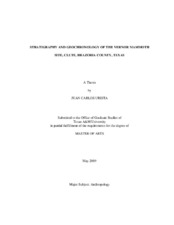| dc.contributor.advisor | Waters, Michael R. | |
| dc.creator | Urista, Juan C. | |
| dc.date.accessioned | 2010-01-16T00:05:42Z | |
| dc.date.available | 2010-01-16T00:05:42Z | |
| dc.date.created | 2009-05 | |
| dc.date.issued | 2010-01-16 | |
| dc.identifier.uri | https://hdl.handle.net/1969.1/ETD-TAMU-2009-05-345 | |
| dc.description.abstract | Remains of a mammoth, other Pleistocene fauna, and a wooden bowl were
recovered from the Vernor site located in Clute, Brazoria County on the Texas Gulf
Coast. Stratigraphy, sedimentology, and geochronology were used to establish the
depositional history of the site. The geologic evidence suggests that these sediments
were deposited during a period of fluvial activity by an ancient meander belt of the
Brazos River, known today as Oyster Creek, which characterized this region during the
Late Pleistocene and Early Holocene. Organics associated with the wooden bowl were
radiocarbon dated to 4205 + 30 yr B.P. (UCIAMS-12039), while sand grains associated
with the remains of the mammoth were dated using the luminescence technique to
66,000 + 7000 yr B.P. (UIC1383). According to these dates and their positions in the
stratigraphic record, it was established that the mammoth and other Pleistocene age
fauna preceded human occupation, and are not contemporaneous with the wooden bowl. | en |
| dc.format.mimetype | application/pdf | |
| dc.language.iso | en_US | |
| dc.subject | geoarchaeology, stratigraphy, geochronology, Vernor, Mammoth, Texas, Coast | en |
| dc.title | STRATIRGAPHY AND GEOCHRONOLOGY OF THE VERNOR MAMMOTH SITE, CLUTE, BRAZORIA COUNTY, TEXAS | en |
| dc.type | Book | en |
| dc.type | Thesis | en |
| thesis.degree.department | Anthropology | en |
| thesis.degree.discipline | Anthropology | en |
| thesis.degree.grantor | Texas A&M University | en |
| thesis.degree.name | Master of Arts | en |
| thesis.degree.level | Masters | en |
| dc.contributor.committeeMember | de Ruiter, Daryl | |
| dc.contributor.committeeMember | Morgan, Cristine | |
| dc.type.genre | Electronic Thesis | en |


